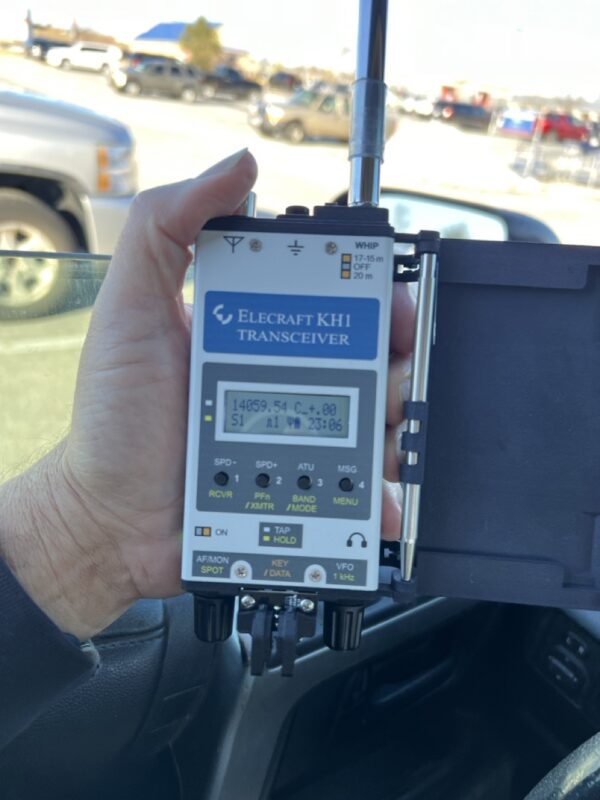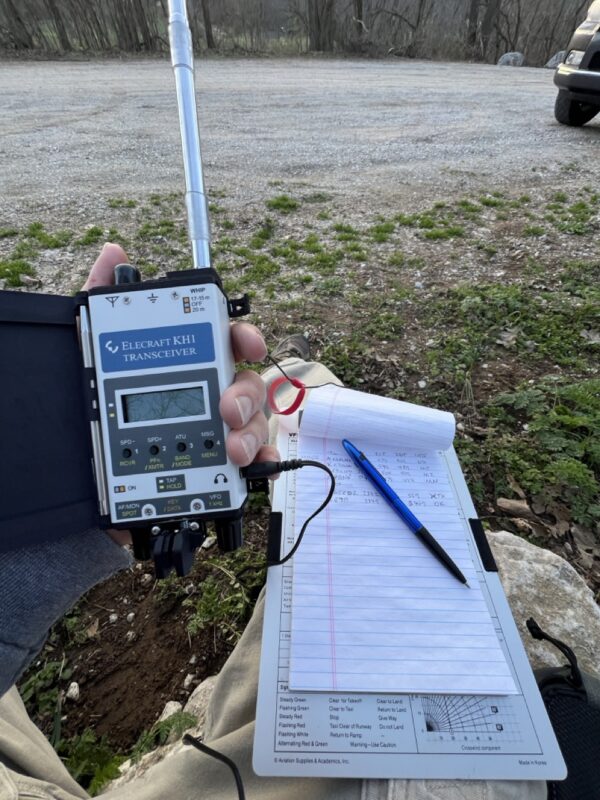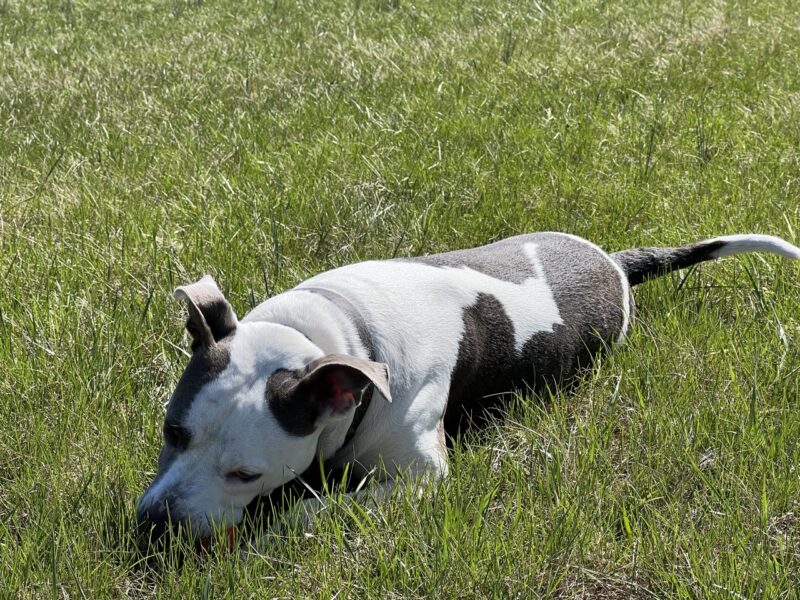
This is not a formal review. There are plenty of those out there in the wild. This article is a bit of my experience in using this little rig in the field. Perhaps someone will find something useful from my experience.
The KH1 was designed by one of my favorite radio engineers, Wayne Burdick of Elecraft. I do not know how long the little rig was in development, but it was released late in 2023. I ordered mine on 20 October 2023, an hour after I learned of its existence. It was delivered in February 2024.
- It is a five-band CW mode (Morse Code) ham radio transceiver that is small enough to fit in my hand.
- It has an internal battery pack that will run it for hours.
- It has a small set of paddles that will store in their socket on the bottom of the radio.
- Two knobs on the bottom provide access to volume and VFO and protect the paddles.
- There are four small buttons on the front panel that provide access to many regularly used functions.
- There is an internal speaker, but the little rig sounds much better with phones.
- The rig has an internal log feature.
- It will run with a short telescoping whip antenna and a counterpoise affixed to the radio.
There are a lot more features to the KH1 than listed above. But you can induct from that list.
There is a menu system for features/settings not directly settable from the front panel and bottom controls. The menu requires some learning and reading the manual is suggested. (I need to read it again a couple of times.) The manual is well written and complete to the best of my knowledge.
The display is bright and readable in daylight. It is backlit so is readable in low light. The bottom line can display decoded Morse Code if desired.
Deployment of the radio is very quick. The steps are:
- Retrieve the radio from its bag (or other storage).
- Affix the telescoping whip to its stud and extend it.
- Attach the counterpoise and throw it out on the ground. (Or let it droop from the drivers side window of your rig if waiting for your SO to finish shopping.)
- Unplug, turn over, and reinsert the paddles into their socket.
- Turn on the radio and start operating.
I can have mine running in less than five minutes. It will match 15m, 17m, and 20m easily with the internal loading coil. It will kinda-sorta match 30m with same internal loading coil. The 40m will not match without help. The best I can tell, one can still operate the KH1 on 40 meters as the finals are resilient, but power is reduced.
Right after I received mine, I carried it with me one afternoon when I drove over to Lowe’s to pick up my son from work. While waiting, I deployed the counterpoise, affixed the whip, and was operating the KH1 with the antenna sticking out my slightly open drivers side window. (It was cold.) I chased three POTA activators while waiting the few minutes for my son. Recovery did not take much longer than deployment and we were off for home.
The receiver is very good. I do not have its specs and I do not care. I find that I hear plenty of signals and the three filter levels work well for my style of operating. When chasing activators, I can use a little XIT (transmitter incremental tuning) to move my sidetone away from the pack so the operator can hear me a little better than the others.
Rejection of strong adjacent signals is solid. I expect this from Elecraft radios.
I have used the KH1 to activate several parks for the Parks on the Air program. I am still getting used to the little paddles, but they function well and are adjustable. I use a pilot’s kneeboard to log on paper. I might be able to position my iPhone on the kneeboard and use it for logging as well. But, for now, I am logging on paper.
I also have the Elecraft AX1 and AXE compromise antenna systems. Given that the KH1 already has a loading coil and switch for the 15m, 17m, and 20m bands, the AX1 seems superfluous. However, I mounted the AXE on the antenna stud and affixed the 33ft counterpoise that accompanies the AXE to the KH1 and pressed the ATU button for 7.060MHz. The KH1 buzzed and fidgeted a moment before returning a 1.2 or 1.3 SWR match. This is plenty good enough to operate on 40m.
My KH1 puts out about four watts (indicated) on the 40m band. That is enough.
With the AXE and long counterpoise attached, the KH1 will find a match on the 30m band as well. I flipped the switch to the 15m/17m side and hit the ATU button. I got a 1.1 SWR match.
I removed the AXE but left the long counterpoise attached to my KH1 and the rig will match frequencies on the 15m, 17m, and 20m bands easily with the longer counterpoise. That means all I have to do is remove the AXE from the rig and replace the whip and I can operate on the higher bands. That makes changing bands very fast.
After several POTA activations and a SOTA activation, I really like this little radio. It does everything my KX1 does but adds the 15m and 17m bands, which I find more useful for my field operations. I have other rigs that will do the other bands if I want them.
I have not done much with wire antennas and the KH1 yet. That is an area I need to explore and I will.
I have an unbuilt MTR5b in my inventory that I bought to get 15m in a pack-friendly radio. Now it seems I will not need the 5b.
I really like the Elecraft KH1. I plan to use it a lot this summer. I will also know a lot more about using the rig in a few more months.

